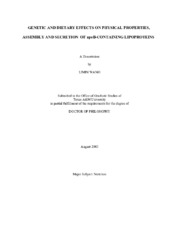| dc.description.abstract | The physical properties (i.e., mass, particle diameter and composition) of apolipoprotein B (apoB)-containing lipoproteins (apoB-LP) are a major determinant of atherosclerotic cardiovascular disease (ASCVD) risk. The objective of this research was to investigate how nascent apoB-LP physical properties affect circulating lipoprotein profiles and risk of disease. Relationships between apoB-LP physical properties and arterial plaque formation in four genotypes of mice with apoB isoform specific clearance defects were investigated. Multivariate statistical analysis found that arterial lesions were most closely related to genetic background and apoB concentration related to delayed clearance rate. For defining the dietary effects on circulating lipoprotein profiles, the physical properties of lipoproteins in hamsters fed high-carbohydrate diets containing either 60% fructose or 60% cornstarch for 2 wk were studied. Fructose increased very low-density lipoprotein (VLDL) particle diameter and decreased low-density lipoprotein (LDL) particle diameter. Elevations in all high-density lipoprotein (HDL) fractions were observed in the fructose-fed group. Further investigation was made of whether changes to the physical properties in circulating lipoproteins resulted from changes to nascent particles in the assembly and secretion processes. Intermediate particles used for lipoprotein assembly were isolated from rough endoplasmic reticulum of hamster liver, and nascent VLDL were isolated from plasma after Triton WR-1339 injection of hamsters. A large, TG-rich apoB-deficient particle and a small, lipid-poor apoB-containing particle were isolated in each dietary setting. The diameter of first-step particles was larger in fructose feeding, which indicated that apoB degradation decreases and provides the basis for apoB oversecretion. Fructose feeding significantly increased the concentrations recovered from liver for these two particles and for nascent particles compared with chow or starch feeding. Collectively, these results demonstrate: 1) genetic factors can dictate metabolism, and metabolic conditions can critically affect the physical properties and further atherogenicity of apoB-LP; 2) changes in physical properties of circulating apoB-LP are derived from changes to the nascent particles; and 3) dietary factors can influence the assembly, secretion, and metabolism of apoB-LP. The findings of the research may provide a metabolic basis for the recognition of new targets that could regulate apoB-LP metabolism to prevent and treat ASCVD. | en |


